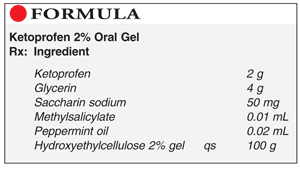US Pharm. 2009;343(10):48-51.

Method of Preparation: Calculate the quantity of each ingredient for the amount to be prepared. Accurately weigh or measure each ingredient. Mix the ketoprofen and saccharin sodium with the glycerin to form a smooth paste. Incorporate about 90 g of the hydroxyethylcellulose (HEC) 2% gel. Prepare a dilution, in alcohol, of the methylsalicylate and peppermint oil. Add the required aliquot of the methylsalicylate and peppermint-oil dilution to the preparation; mix well. Add sufficient HEC 2% gel to final weight; mix well. Package and label.
Use: Ketoprofen oral gel has been used to treat inflammation and pain in the oral cavity.
Packaging: Package in tight, light-resistant containers.
Labeling: Use only as directed. Keep out of the reach of children.
Stability: A beyond-use date of 30 days may be used for this preparation.1
Quality Control: Quality-control assessment can include theoretical weight compared with actual weight, pH, specific gravity, active drug assay, color, clarity, texture-surface, texture-spatula spread, appearance, feel, rheologic properties, and physical observation.2
Discussion: Ketoprofen (C16H14O3, MW 254.28) occurs as a white or almost white, odorless or almost odorless, crystalline powder. It is practically insoluble in water, but is freely soluble in alcohol and ether. Ketoprofen has analgesic, anti-inflammatory, and antipyretic properties, and it is an inhibitor of cyclooxygenase.1,3
Glycerin (glycerol, 1,2,3-propanetriol) occurs as a clear, colorless, odorless, viscous, hygroscopic liquid with a sweet taste about two-thirds as sweet as sucrose. It is miscible with water and 95% ethanol and is practically insoluble in oils. Glycerin is hygroscopic and should be stored in an airtight container in a cool place.4
Saccharin sodium (soluble saccharin, Sucaryl, Sweeta with sorbitol) is an intense sweetening agent with an MW of 205 for the anhydrous form. It is a white, odorless or faintly aromatic, efflorescent, crystalline powder with an intensely sweet taste and a metallic aftertaste. A 10% solution has a pH of about 6.6. One g is soluble in about 1.2 mL water, 50 mL 95% ethanol, and 3.5 mL propylene glycol.5
Methylsalicylate (C8H8O3, MW 152.15) is produced synthetically or is obtained by maceration and subsequent distillation with steam from the leaves of Gaultheria procumbens Linné (fam. Ericaceae) or from the bark of Betula lenta Linné (fam. Betulaceae). It occurs as a colorless, yellowish, or reddish liquid with the characteristic odor and taste of wintergreen. It is slightly soluble in water and soluble in alcohol and glacial acetic acid.6
Peppermint oil is a volatile oil that is distilled with steam from the fresh overground parts of Mentha piperita, rectified by distillation, and neither partially nor wholly dementholized. It occurs as a colorless or pale yellow liquid with a strong, penetrating odor of peppermint and a pungent taste followed by a sensation of cold when air is drawn into the mouth. It is soluble 1 volume in 3 volumes of 70% alcohol, and it has a specific gravity of 0.896 to 0.908.7
HEC occurs as a light tan or cream to white-colored, odorless, tasteless powder. HEC is a nonionic, water-soluble polymer used especially as a thickening agent in ophthalmic formulations. The pH of a 1% aqueous solution is in the range of 5.5 to 8.5. HEC is soluble in hot or cold water, but is practically insoluble in acetone, ethanol, and most organic solvents. Solutions may be easily made by dispersing the HEC in mildly agitated water at room temperature. When the powder has been thoroughly wetted, increasing the temperature to 60˚C to 70˚C speeds the dispersion process. Adding a small amount of an alkalizing agent to the solution also enhances dispersion. Preparing a slurry of the HEC powder with a nonaqueous solvent, such as ethanol, prior to dispersion makes the processes easier. HEC is a stable powder, but it is hygroscopic. Solutions are more stable at pH values above 5, even though the dispersions are categorized as stable between pH values of 2 and 12.8
REFERENCES
1. US Pharmacopeial Convention, Inc. USP Pharmacists' Pharmacopeia. 2nd ed. Rockville, MD: US Pharmacopeial Convention, Inc; 2008:775-779.
2. Allen LV Jr. Standard operating procedure for performing physical quality assessment of ointments/creams/gels. IJPC. 1998;2:308-309.
3. Reynolds JEF, ed. Martindale: The Extra Pharmacopoeia. 30th ed. London, England: Pharmaceutical Press; 1993:21-22.
4. Alvarez-Nunez FA, Medina C. Glycerin. In: Rowe RC, Sheskey PJ, Quinn ME, eds. Handbook of Pharmaceutical Excipients. 6th ed. Washington, DC: American Pharmaceutical Association; 2009:283-286.
5. Hoppu P. Saccharin sodium. In: Rowe RC, Sheskey PJ, Quinn ME, eds. Handbook of Pharmaceutical Excipients. 6th ed. Washington, DC: American Pharmaceutical Association; 2009:608-610.
6. Reynolds JEF, ed. Martindale: The Extra Pharmacopoeia. 30th ed. London, England: Pharmaceutical Press; 1993:24.
7. Reilly WJ Jr. Pharmaceutical necessities. In: Troy DB. Remington: The Science and Practice of Pharmacy. 21st ed. Philadelphia, PA: Lippincott Williams & Wilkins; 2006:1066.
8. Hapgood KP. Hydroxyethyl cellulose. In: Rowe RC, Sheskey PJ, Quinn ME, eds. Handbook of Pharmaceutical Excipients. 6th ed. Washington, DC: American Pharmaceutical Association; 2009:311-314.





